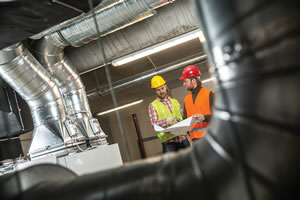The Boiler Room Is the Classroom

PHOTOS © URBANS
Students and professors rarely give a
thought to the machinery and systems that run their
campus — unless something goes wrong and they end up
sweating or shivering. But college and university physical plants
could serve as more than unseen controllers of the classroom
environment; they could be the classroom.
Facilities leaders faced with curtailing rising costs and meeting
sustainability targets while keeping building occupants comfortable
and maintaining climate control for labs and other sensitive
spaces need increasingly sophisticated systems to achieve their
goals. These systems justify themselves based on hard-dollar
returns on investment. But looking at them only through that lens
misses a significant opportunity to contribute to the institution’s
educational mission.
Campus physical plants that have become “Internets of things” —
requiring cloud-based management, machine learning and
visualization tools — could be living labs for students. Mechanical
engineering students could explore the plant with managers and engineers
to see how a cutting-edge HVAC system works, for example,
and visualization tools could bring the plant into the classroom.
The Optimized HVAC Lab
What will students see when they look inside an advanced
campus HVAC system?
At Baylor University in Texas, they’ll see a solution to the problem
posed by mixed-equipment systems — a common situation.
Baylor’s chiller plant comprises eight chillers of different sizes and
ages, which presents a hydraulics challenge: how do you properly
distribute the total flow through the chillers when each of them has
a different pressure drop? The chilled
water will naturally go through the
chiller with the lowest pressure drop,
and far less flow will go through the
chiller with the highest pressure
drop. Students might think you’d use
the modulating isolation valve on the
chillers to balance the flow, but with
eight chillers you have 256 possible
run combinations, so fixed-valve positions for balancing flow
won’t work. The answer was to develop an algorithm that dynamically
adjusts valve positions so that the system is balanced under
any combination of chillers and flow. The plant saved 3.55 million
kilowatt-hours and 5.26 million pounds of CO2 within the first year
of its optimization.
Another university we work with could walk students through
the same challenge doubled, plus the extra problem of connecting
to cloud-based optimization software under a strict security
regime. The tech-focused university has two plants — one with six
chillers and the other with seven — and requires that its control
system remain completely isolated from the Internet. Our engineering
team had to figure out how
to pass data from the plant to off-site
management servers without compromising
the plant control system’s
network security. The solution was to
use data loggers that isolate network
traffic on one side from network
traffic on the other. The data loggers
contain registers that the control
system can write values to, and the university’s servers read that
data. Data can be written to the data loggers only from the control
system network, and data can be read from the data loggers only
from the network on which the servers reside. The off-site servers then pull the data from the network into cloud architecture. Expected
savings from the plant’s optimization are 17.2 million kWh
and 31.5 million pounds of CO2.
Newer plants have teaching potential as well. The University of
Maryland’s Institute for Bioscience and Biotechnology Research
(IBBR) shows how a five-year-old plant with inflexible climate requirements
can run more efficiently with the right strategy and technology.
James Johnson, the university’s director of facilities and lab
services, converted IBBR to an all-variable flow plant and then added
an optimization and control layer. From the variable speed drives
and sensors installed on chillers, pumps, valves and tower fans,
the software collects a tremendous amount of data about the plant
equipment, including water flow, electrical power consumption, load
conditions and more. It compares the data to control algorithms, assesses
plant conditions in real time, and then automatically changes
pump and fan speeds using chilled water temperature, equipment
staging and other operational changes to maximize efficiency. The
plant now runs 27 to 37 percent more efficiently.

PHOTOS © URBANS
Real-World Experience for Future Engineers
Now is the perfect time for colleges and universities to turn
their HVAC plants into living labs. Recent technology advances
enable a real leap forward in efficiency, and many aging campus
systems are overdue for replacement or upgrade. As energy
optimization pioneer Tom Hartman observed last year in a blog
post after the International District Energy Association Campus
Energy Summit, campus planners have put off dealing with
outdated steam distribution systems for decades, and they are now
realizing it doesn’t make sense to keep sinking money into shoring
up obsolete technology. Replacement systems will incorporate
efficient processes like thermal transfer (the use of heat rejected
from chilled water production to produce hot water) and thermal
storage. They’ll also use an optimization platform as a central
nervous system that continuously monitors the system and adjusts
equipment operations to keep it performing efficiently over time.
Students will want to look inside all those elements. I’ve seen
firsthand that students crave a hands-on experience with the latest
technologies. At the Institute for Sustainability and Engineering
at Northwestern University, my alma mater, I’m teaching an
entrepreneurship class with two other clean-tech executives. It’s
clear that students need to understand real-world applications and
how to commercialize solutions. Part of our mission is to educate
and innovate, and universities are where technology innovation
happens. We will gladly have engineers work with students on-site
at our installations.
Schools that view their HVAC plants as part of the educational
experience can engage their students with the next generation of
building technology in a way that gives them the insights needed
to develop ever simpler, more powerful and more cost-effective
building systems. What’s a bigger ROI than that?
This article originally appeared in the issue of .
About the Author
Bert Valdman is president and CEO of Optimum Energy, a
Seattle-based software and engineering firm that optimizes
HVAC systems. He was senior vice president of strategy at Edison
International and chief operating officer of Puget Sound Energy. Follow his
company on Twitter @TrueOptimize.